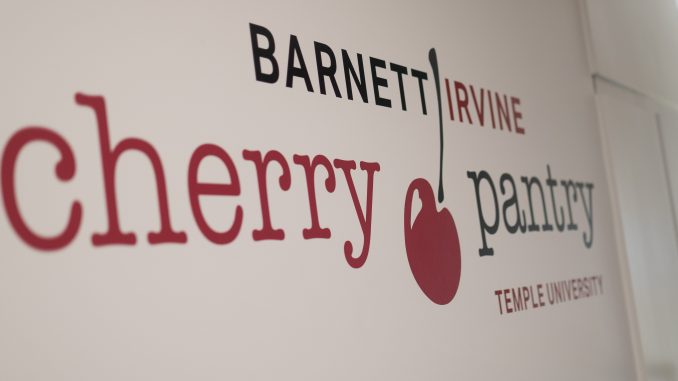
Tanvi Kumar has struggled with balancing school while also being able to afford healthy meals.
“I would go to grocery stores and only buy one carton of food because I couldn’t afford more,” said Kumar, a junior journalism major.
Now, for the past couple of weeks, Kumar has been utilizing Temple’s Barnett & Irvine Cherry Pantry.
“Going to the Cherry Pantry has really helped me cut down costs and focus on what really matters, like my studies,” Kumar said.
The Cherry Pantry, which provides Temple students with free access to non-perishables, produce and hygiene products, introduced a pilot program on Temple’s Center City and Ambler campuses on April 4 and 5, respectively.
For the remainder of the Spring 2023 semester, the Cherry Pantry will hold distribution events weekly at the Center City and Ambler campuses as part of the pilot program. Students can visit the campuses’ designated distribution sites and pick up a pre-packaged bag that contains 15-20 items that could be found at the Main Campus Cherry Pantry, Ditolvo said.
The program differs from the Cherry Pantry at Main Campus, where students can visit the pantry and pick out the items they want, similar to a grocery trip.
The program was created to explore the extent of basic needs insecurity at other Temple campuses and to broaden its reach. Students are not required to show financial need to use the pantry.
“We exist to support students’ basic needs because it is so important that those are met in college,” said Annette Ditolvo, the program coordinator.
Before this system appears at Center City and Ambler, the organization needs to determine what type of need exists, Ditolvo said. At Main Campus, the Cherry Pantry receives approximately 195 visitors a week.
“We’re really seeing what the needs are of our students at these campuses,” Ditolvo said.
Twenty-nine percent of students enrolled at four-year colleges experienced food insecurity, according to a 2020 survey by the Hope Center for College, Community and Justice. Food-insecure students have 42 percent lower odds of graduating, according to a study by Front Public Health.
“We wanted to make as little accessibility barriers as possible, so we’re expanding to regional campuses to make sure that we’re servicing the broader community,” Ditolvo said.
Students who face food insecurity tend to choose cheap and fast food, which can cause lasting health conditions, according to Health Affairs, a journal that covers health-related topics. Additionally, people who don’t have reliable access to food are more likely to report symptoms of stress and depression.
Chelsea Lubbe, a freshman journalism major and volunteer at the Cherry Pantry, is excited to see the program being expanded to other Temple campuses and believes it will be a valuable asset to students.
Varasiddhi Vinay, a sophomore speech, language and hearing science major who visits the Cherry Pantry, also believes the expansion to Temple’s regional campuses is valuable.
“It makes it a lot easier for college students to focus on their studies versus all of the extra things that come with living on your own,” Vinay said. “If it can be expanded to other students on other campuses I think it’s great.”
There can be a potential stigma against asking for help and visiting a food pantry, according to Health Line. However, Lubbe appreciates the subtleness of the program.
“I think the anonymity of it is something people can find comfort in,” Lubbe said.
Lubbe hopes to see the pilot program expanded to a full pantry, similar to what is at Main Campus.
“I definitely think it should be expanded, going to the pantry creates a feeling of community,” she said.
Ditolvo would like to see more students using this resource and for the service to be expanded, but recognizes that growing numbers unfortunately paint the amount of students in need.
“It’s a double-edged sword when we’re talking about our usage numbers increasing,” Ditolvo said. “It’s great that we’re getting the word out, but it’s concerning to see the amount of need that we have.”



Be the first to comment